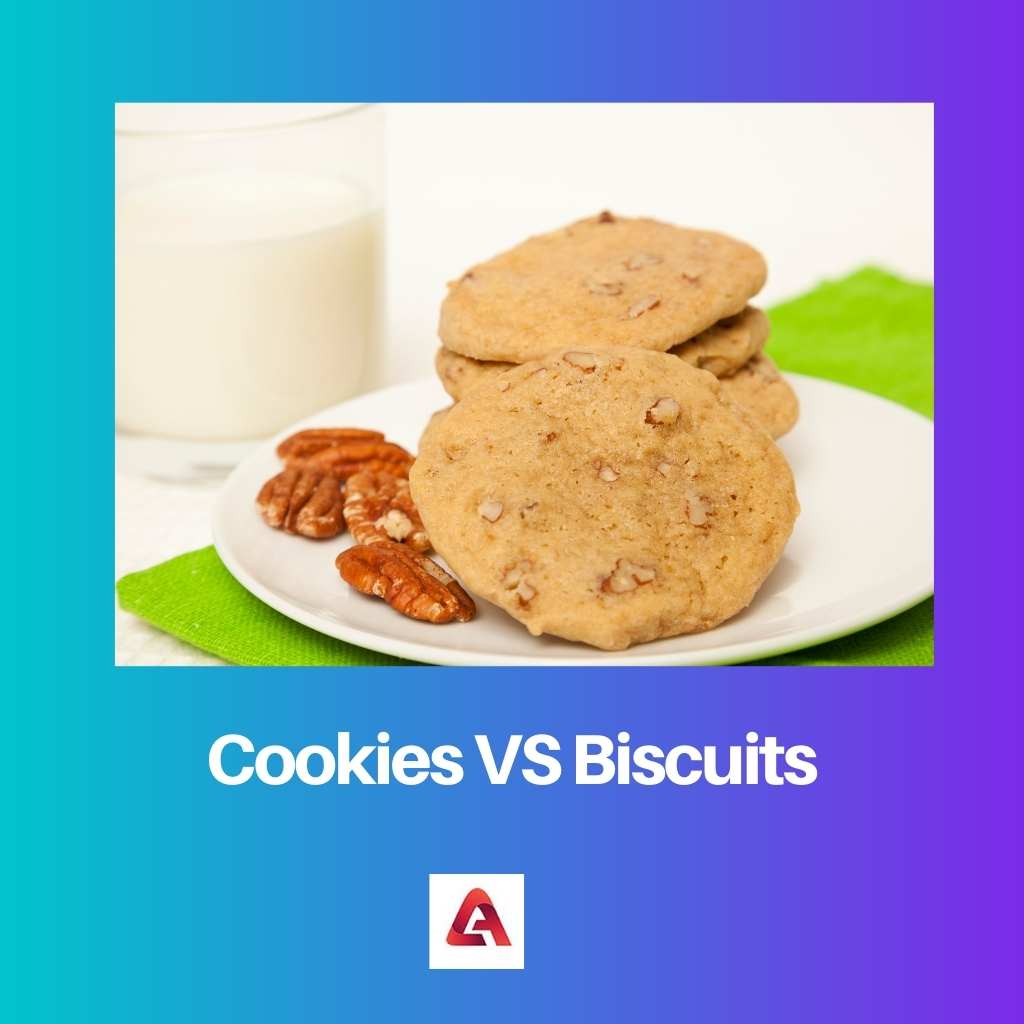Children love to munch on snacks. At times, adults also munch on snacks.
Children and adults eat snacks like cakes and cookies. The flavor and taste of each snack differ.
Names of these food items also change in different countries. Based on the place of origin the method of preparation varied.
Key Takeaways
- Cookies are sweet baked good that is soft and chewy, while biscuits are savory or sweet baked goods that are crisp and crunchy.
- Cookies are more popular in the United States and Canada, while biscuits are more popular in the United Kingdom and Australia.
- Cookies contain chocolate chips, nuts, or other sweet ingredients, while biscuits are flavored with herbs, cheese, or other savory ingredients.
Cookies vs Biscuits
Cookies are small, sweet baked treats that are crispy on the outside and chewy on the inside. They come in a variety of flavors, shapes, and textures. Biscuits are used to describe a wider range of baked goods. They can be sweet or savory, ranging from crispy and crunchy to soft and crumbly.

Cookies are small, rounded, and sweet. They are dense with nuts or raisins added.
Cookies are commonly rounded but may also change in shape. Square or bar-shaped cookies are available.
Cookies are stored in containers called cookie jars. These are glass containers with metal lids.
Since the containers are air-tight they prevent the cookies from spoiling. Cookies are chewy.
Biscuits are flat-baked products. Sugar, chocolate, jam, or cinnamon are added to biscuits. They are commonly sweet.
Cream, chocolate, jam, or honey forms the filling. Bourbon is the most famous sandwich biscuit.
Flour, milk, salt, butter, and oil are essential for making biscuits. Salt and paprika gave savory variants.
Placing biscuits and milk for Santa is a way old custom.
Comparison Table
| Parameter of Comparison | Cookies | Biscuits |
|---|---|---|
| Country | America | UK |
| Sugar content | High | Low |
| Derived from | Koekje | Bescuit |
| Texture | Dense and chewy | Crunchy and thin |
| Ingredients | More | Few |
What are Cookies?
The term cookie is used in North America. A plain bun is called a cookie in Scotland. In British English, the cookies baked on a tray and cut into bars are bar cookies.
Traybakes is another name for bar cookies. The word, Cookie was first used by the Scottish to refer to the plain bun in the 1700s.
In 1808 Americans started using the word for small flat sweet cakes. Americans derived this word from the Dutch word, koekje meaning, little cakes.
Some believe that this word was used by the Dutch settlers in America in the early 1600s. Cookies are baked till they become crisp.
Sugars, spices, peanut butter, chocolate, nuts, and dried fruits are used for making cookies.
Duration of baking affects the softness of cookies. Though cookies are considered small cakes, they don’t use the cohesive agent of cakes.
Cake batter makes use of water when cookie dough uses oil. Butter, lard, or vegetable oils are used. So, cookies with oil are dense and crispier than cakes.
Cookies have various types. Dropping a spoonful of soft cookie dough on a sheet gave drop cookies.
The sheet is spread on a tray placed in the oven. These mounts flatten during baking.
In Filled cookies, the dough is rolled. Fillings like jam are kept in the middle and baked.
Molded cookies like peanut butter cookies are molded into balls and baked. No-bake cookies are hardened by cooling instead of baking.
Gingerbread cookies epitomize winter snacks.

What are Biscuits?
Biscuit originated from the old French term bescuit. It has a Latin origin. Words bis and coquere formed bescuit meaning twice-cooked.
Biscuit-making involved two steps. It was baked first and then allowed to dry in the oven.
This term was used by the British, in the 1400s
Biscuits are suitable for travel. They are small and easy to store.
Biscuits were preferred by Sailors, for their long sea journey. They don’t spoil for a long time.
Roman sailors used biscuits called buccellum for travel. Physicians also believed that biscuits help with digestive issues like indigestion.
They recommend people to consume biscuits daily.
Biscuits swith time. It was a goal for the chefs to bake the hard biscuits.
They made biscuits hard to prevent them from softening and spoiling. Biscuits meant for voyages were baked four times.
That gave them a hard texture. In dry condition, they remained unspoiled for many years.
Sailors ate them on their long sea voyages.
Hard biscuits were tough to bite and dipped in liquids like coffee or tea. Cooking hard biscuits in a skillet meal was also common.
Confectionery biscuits were sweet and had chocolate added to it. Spiced biscuits include gingerbreads.
With the advent of industries, biscuits were made in Industries and marketed. The British introduced biscuits to South Asia.

Main Differences Between Cookies and Biscuits
- Cookies are heavier. They have a crispness and a hard texture. Biscuits are Crunchy and fluffy. They are easy to bite and chew. Cookies are chewy
- Cookies are rich in sugar. Biscuits have a comparably low amount of sugar. On occasions, Biscuits without sugar are baked
- The term cookie originated from the Dutch word koekje. While biscuits originated from the French term bescuit.
- Chocolate chips, raisins, and almonds in cookies enhance the taste. These extra ingredients are absent in the biscuit dough
- Cookies take a long time to bake since they are dense. Biscuits are thin and take a short time

- https://www.degruyter.com/document/doi/10.2202/1556-3758.1638/html
- https://www.tandfonline.com/doi/abs/10.3109/09637486.2013.800845
